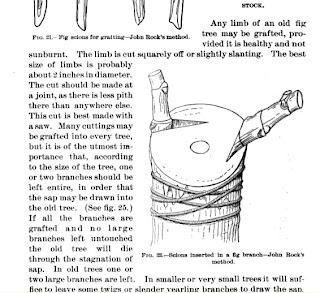Sunday, March 29, 2009
Quince with Chickadee
Saturday, March 28, 2009
Fig Grafting. More from Eisen's 1901 book.
Additional information from Eisen's book, available from Google online here. I was interested due to the grafting information. In the Gardenweb Fig Forum, contributers state that grafting is difficult or can't be done. It's exciting to see that the method used successfully in the 19th century are what I recently tried. Who knows if they will take, still too early.
My copies & editing are awkward, but get the point across.
 Interesting - here, thought not to be difficult! Cool!
Interesting - here, thought not to be difficult! Cool!
 Close to how I cut scions, so I have some hope that's a good sign.
Close to how I cut scions, so I have some hope that's a good sign.
My copies & editing are awkward, but get the point across.
 Interesting - here, thought not to be difficult! Cool!
Interesting - here, thought not to be difficult! Cool! Close to how I cut scions, so I have some hope that's a good sign.
Close to how I cut scions, so I have some hope that's a good sign.Fig Cuttings. Eisen's 1901 Illustrations.
From a scanned book from Google's project, accessible here.. This is public domain, not copyright protected, so OK to post here.
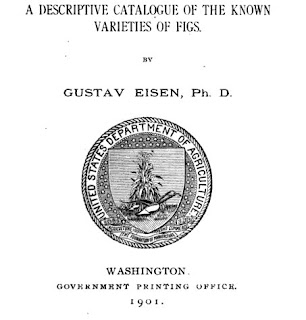 Title page from Gustav Eisen's book
Title page from Gustav Eisen's book
 I haven't seen this before. This illustration shows split view of cutting. The claim is that cutting should not be cut exposing the pith.
I haven't seen this before. This illustration shows split view of cutting. The claim is that cutting should not be cut exposing the pith.
 Various cutting methods.
Various cutting methods.
Amazing, learning new concepts from a book that is over 100 years old.
 Title page from Gustav Eisen's book
Title page from Gustav Eisen's book I haven't seen this before. This illustration shows split view of cutting. The claim is that cutting should not be cut exposing the pith.
I haven't seen this before. This illustration shows split view of cutting. The claim is that cutting should not be cut exposing the pith. Various cutting methods.
Various cutting methods.Amazing, learning new concepts from a book that is over 100 years old.
I can't help it. Had to post.
Nothing to do with being green, gardening, chickens, or biking. But too funny to pass up
Sunday, March 22, 2009
Easily Entertained
Buds: Phenological photos.
Phenology - keeping track of natural progression of plant growth and other events, in an effort to know when to plan agricultural activities. See other entries by clicking on labels. Here are some events in my yard currently, especially flower buds, leaves unfolding, and growth beginning for various plants.
 Pear flower bud, almost open.
Pear flower bud, almost open.
 Lilac flower bud. This is the first to show little purple 'grapes' within the bud.
Lilac flower bud. This is the first to show little purple 'grapes' within the bud.
Saturday, March 21, 2009
Spring Garden Chores
Today (Saturday), I...
Weeded the rose bed. This bed now has almost as many fruit trees, brambles, and plants, as roses, but still contains about 10 rose bushes. I had moved one rose bush to accomodate the new Surefire cherry, and today moved a second one a little further from that new tree. I also moved a David Austin rose from the front yard, and a peony as well. It looks like I butchered the thick peony roots, even though I thought I was digging a wide distance from the stems. We'll see if it grows. It's interesting how few roots the roses seem to have - surprising that they survive moving. I pruned the tops further back to balance the reduced root mass.
 Mulched the rose bed with bark mulch. It's now basically ready for Spring and Summer. I did not add compust to most of it this year, because the roses were too rampant last year and I don't want to overstimulate the fruits and roses. I did give some chicken manure to the roses that I moved.
Mulched the rose bed with bark mulch. It's now basically ready for Spring and Summer. I did not add compust to most of it this year, because the roses were too rampant last year and I don't want to overstimulate the fruits and roses. I did give some chicken manure to the roses that I moved.
Sprayed most of the fruit trees and roses with Neem oil. Not the peaches - the flowers are opening.
Moved one Orchard Mason Bee house to the front yard, since there are many fruit trees there as well.
 Turned over the soil in the tomato patch.
Turned over the soil in the tomato patch.
Pruned the remaining rose bushes.
Stood around and stared at the results of my labors.
 Grafted 3 fig scions onto the petite negri tree. Just to see if I can. According to most references, it can't be done. I hope they are wrong.
Grafted 3 fig scions onto the petite negri tree. Just to see if I can. According to most references, it can't be done. I hope they are wrong.
 This time I used rubber bands to tie, and used plastic tape to cover and protect. The plastic tape was made by slicing a ziplock sandwich bag. Also used petroleum jelly as an antidessicant, as I did with the apple grafts. It's not just stubbornness - I really would like to see if they grow.
This time I used rubber bands to tie, and used plastic tape to cover and protect. The plastic tape was made by slicing a ziplock sandwich bag. Also used petroleum jelly as an antidessicant, as I did with the apple grafts. It's not just stubbornness - I really would like to see if they grow.
Added some petroleum jelly to the apple grafts - forgot to do that earlier, purpose is to serve as antidessicant.
 Also mulched around this red-bark Japanese maple, that I moved to this location a few days ago. It was a seedling in the rose bed, among many others. I had never got around to pulling it up, and now will see how it does as a specimen tree.
Also mulched around this red-bark Japanese maple, that I moved to this location a few days ago. It was a seedling in the rose bed, among many others. I had never got around to pulling it up, and now will see how it does as a specimen tree.
Weeded the rose bed. This bed now has almost as many fruit trees, brambles, and plants, as roses, but still contains about 10 rose bushes. I had moved one rose bush to accomodate the new Surefire cherry, and today moved a second one a little further from that new tree. I also moved a David Austin rose from the front yard, and a peony as well. It looks like I butchered the thick peony roots, even though I thought I was digging a wide distance from the stems. We'll see if it grows. It's interesting how few roots the roses seem to have - surprising that they survive moving. I pruned the tops further back to balance the reduced root mass.
Sprayed most of the fruit trees and roses with Neem oil. Not the peaches - the flowers are opening.
Moved one Orchard Mason Bee house to the front yard, since there are many fruit trees there as well.
Pruned the remaining rose bushes.
Stood around and stared at the results of my labors.
Added some petroleum jelly to the apple grafts - forgot to do that earlier, purpose is to serve as antidessicant.
Labels:
fig grafting,
fruit tree,
grafting,
mulch,
neem oil,
Orchard Mason Bee,
peach,
roses
Thursday, March 19, 2009
Harbingers of Spring. Two New Fruit Trees. Phenology.
Labels:
Asian pear,
cherry,
phenology,
Spring flowers
Sunday, March 15, 2009
Fig Grafting Experiment
I don't have enough fig starts to do a big experiment. This is a Petite negri that was started almost by accident from a cutting 2 years ago - stick stuck into the ground in the onion bed, just to see if it would grow. Last fall I dug it out and transferred to a container, and kept it in the garage to overwinter during the coldest weather. It's been outside again for about one month.
I don't really need more fig trees. Here is my thought: I would like to have a containerized tree, with multiple varieties, that I can move indoors for the winter. Doing so might preserve the breba crop. Petite negri is naturally small and slow growing, with short interstems. If PN can be used as a rootstock, just maybe the small, slow growing trait would be passed on to the scion. I could use the scion as the start for a multigraft tree.
I don't know if figs can be grafted this way. Since they grow so easily from cuttings, there isn't much reason for grafting. So this is my attempt. I used reverse saddle graft because it seems like the easiest method. Unlike the apples, I used rubber bands to tie, and I remembered to cover the grafts with petroleum jelly to hold in moisture.
This tree had 2 stems. That gives me 2 chances. If both grow (counting my grafts before they take), then one can be removed later for a stronger main trunk.
 Petite negri in pot, Brunswick "Vancouver" in bag. The scions had been held in the refridgerator for the winter, with plan to grow cuttings.
Petite negri in pot, Brunswick "Vancouver" in bag. The scions had been held in the refridgerator for the winter, with plan to grow cuttings.
 Both scion and rootstock cut to size that I hope will match.
Both scion and rootstock cut to size that I hope will match.
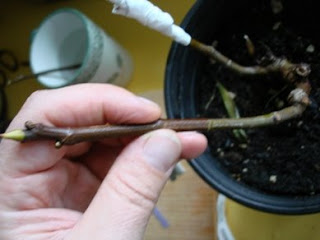 These match very closely.
These match very closely.
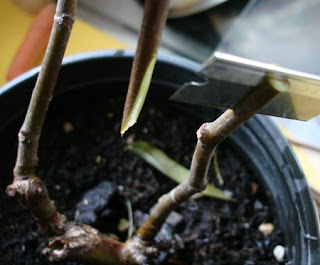 Photo showing cuts for scion and rootstock.
Photo showing cuts for scion and rootstock.
 Same as above, but the other branch.
Same as above, but the other branch.
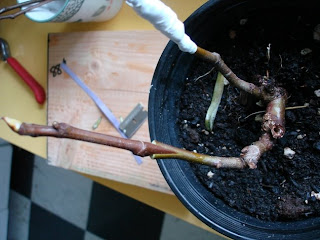 In place. Note to self: After trimming, the scion diameter is a little smaller than the rootstock. If I do this again, adjust so that the scion starts a little bigger, for a closer final match.
In place. Note to self: After trimming, the scion diameter is a little smaller than the rootstock. If I do this again, adjust so that the scion starts a little bigger, for a closer final match.
 One is completed. The other is held in place with a cut rubber band. I am concerned that the deental floss that I used for the apples might be too restricting, and am unsure of when to cut it. The rubber band gives more flexibility, but is more difficult to tie without moving the scion in it's new perch.
One is completed. The other is held in place with a cut rubber band. I am concerned that the deental floss that I used for the apples might be too restricting, and am unsure of when to cut it. The rubber band gives more flexibility, but is more difficult to tie without moving the scion in it's new perch.
 "Real" grafters use asphalt pain or waxes to protect the new graft from dehydration. I'm using petroleum jelly because I already have some. It does not harden, but should have a similar function. I also forgot that step with the apples, but in this chilly rainy season, they might still survive.
"Real" grafters use asphalt pain or waxes to protect the new graft from dehydration. I'm using petroleum jelly because I already have some. It does not harden, but should have a similar function. I also forgot that step with the apples, but in this chilly rainy season, they might still survive.
 Final step - I wrapped them in plumber's teflon tape. It sticks nicely to the petroleum jelly, is easy to handle, and is very stretchy.
Final step - I wrapped them in plumber's teflon tape. It sticks nicely to the petroleum jelly, is easy to handle, and is very stretchy.
Count'em. 10 fingers. No blood. Another sign of success.
Will they 'take'? I'll have to post later with either report of success or failure.
I don't really need more fig trees. Here is my thought: I would like to have a containerized tree, with multiple varieties, that I can move indoors for the winter. Doing so might preserve the breba crop. Petite negri is naturally small and slow growing, with short interstems. If PN can be used as a rootstock, just maybe the small, slow growing trait would be passed on to the scion. I could use the scion as the start for a multigraft tree.
I don't know if figs can be grafted this way. Since they grow so easily from cuttings, there isn't much reason for grafting. So this is my attempt. I used reverse saddle graft because it seems like the easiest method. Unlike the apples, I used rubber bands to tie, and I remembered to cover the grafts with petroleum jelly to hold in moisture.
This tree had 2 stems. That gives me 2 chances. If both grow (counting my grafts before they take), then one can be removed later for a stronger main trunk.
Count'em. 10 fingers. No blood. Another sign of success.
Will they 'take'? I'll have to post later with either report of success or failure.
Subscribe to:
Posts (Atom)
